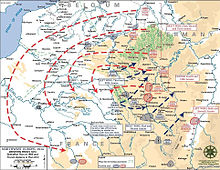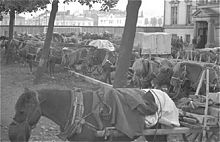Mobilization
This article includes a list of general references, but it lacks sufficient corresponding inline citations. (October 2012) |
Mobilization (alternatively spelled as mobilisation) is the act of assembling and readying military
Mobilization institutionalized the Levée en masse (engl. mass levy of conscripts) that was first introduced during the French Revolution. It became an issue with the introduction of conscription, and the introduction of the railways in the 19th century.
A number of technological and societal changes promoted the move towards a more organized way of deployment. These included the
History
Roman Republic
The Roman Republic was able to mobilize at various times between 6% (81–83 BCE) to as much as 10% (210s BCE) of the total Roman population, in emergencies and for short periods of time.[2] This included poorly-trained militia.
Modern era
The Confederate States of America is estimated to have mobilized about 11% of its free population in the American Civil War (1861–1865).[2] The Kingdom of Prussia mobilized about 6–7% of its total population in the years 1760 and 1813.[2] The Swedish Empire mobilized 7.7% in 1709.[2]
Armies in the seventeenth century possessed an average of 20,000 men.[3] A military force of this size requires around 20 tons of food per day, shelter, as well as all the necessary munitions, transportation (typically horses or mules), tools, and representative garments.[3] Without efficient transportation, mobilizing these average-sized forces was extremely costly, time-consuming, and potentially life-threatening.[3] Soldiers could traverse the terrain to get to war fronts, but they had to carry their supplies.[3] Many armies decided to forage for food;[3] however, foraging restricted movement because it is based on the presumption that the army moves over land possessing significant agricultural production.[3]
However, due to new policies (like conscription), greater populations, and greater national wealth, the nineteenth-century army was composed of an average of 100,000 men. For example, in 1812 Napoleon led an army of 600,000 to Moscow while feeding off plentiful agricultural products introduced by the turn of the century, such as potatoes.[4] Despite the advantages of mass armies, mobilizing forces of this magnitude took much more time than it had in the past.[5]
The Second Italian War of Independence illustrated all of the problems in modern army mobilization. Prussia began to realize the future of mobilizing mass armies when Napoleon III transported 130,000 soldiers to Italy by military railways in 1859.[5] French caravans that carried the supplies for the French and Piedmontese armies were incredibly slow, and the arms inside these caravans were sloppily organized.[6] These armies were in luck, however, in that their Austrian adversaries experienced similar problems with sluggish supply caravans (one of which apparently covered less than three miles per day).[6]
Not only did Prussia take note of the problems in transporting supplies to armies, but it also took note of the lack of communication between troops, officers, and generals. Austria's army was primarily composed of
Mobilization in World War I

Intricate plans for mobilization contributed greatly to the beginning of World War I, since in 1914, under the laws and customs of warfare then observed (not to mention the desire to avoid compromising national security), general mobilization of one nation's military forces was invariably considered an act of war by that country's likely enemies.
In 1914, the
For example, German military leaders did not plan to mobilize for war with Russia whilst assuming that France would not come to her ally's aid, or vice versa. The
Similarly, the Russian
The next day, the Tsar's foreign minister, Sergey Sazonov once more persuaded Nicholas of the need for general mobilization, and the order was issued that day, July 30. In response, Germany declared war on Russia.
Germany mobilized under
Thus the entangling alliances of the Triple Alliance and the Triple Entente directed the intricate plans for mobilization. This brought all of the Great Powers of Europe into the Great War without actually utilizing the provisions of either alliance.
The mobilization was like a holiday for many of the inexperienced soldiers; for example, some Germans wore flowers in the muzzles of their rifles as they marched. Trains brought soldiers to the front lines of battle. The Germans timetabled the movements of 11,000 trains as they brought troops across the
Britain's
"Colonials" served under British command though, perhaps owing to the limited autonomy granted to the Dominions regarding their respective mobilizations, the Dominions eventually compelled the British government to overrule the objections of some British commanders and let the Dominion forces serve together instead of being distributed amongst various British divisions. The "colonials" would go on to be acknowledged by both the British and German high commands as being elite British units. In May 1918, when command of the Australian Corps passed from William Birdwood to John Monash, it became the first British Empire formation commanded totally free of British officers.
On May 23, 1915, Italy entered World War I on the Allied side. Despite being the weakest of the big four Allied powers, the Italians soon managed to populate its army from 560 to 693 infantry battalions in 1916; the army had grown in size from 1 million to 1.5 million soldiers.[11] On August 17, 1916, Romania entered the war on the Allied side, mobilizing an army of 23 divisions. Romania was quickly defeated however by Germany, Austria-Hungary, and Bulgaria. Bulgaria went so far as to ultimately mobilize 1.2 million men, more than a quarter of its population of 4.3 million people, a greater share of its population than any other country during the war.
The production of supplies gradually increased throughout the war. In Russia, the expansion of industry allowed a 2,000 percent increase in the production of artillery shells - by November 1915, over 1,512,000 artillery shells were being produced per month. In France, a massive mobilization by the female population to work in factories allowed the rate of shell production to reach 100,000 shells a day by 1915.[12]
Both sides also began drawing on larger numbers of soldiers. The British Secretary of State for War,
On April 6, 1917, the
Mobilization in World War II


Canada actually carried out a partial mobilization on August 25, 1939, in anticipation of the growing
The United Kingdom mobilized 22% of its total population for direct military service, more than any other nation in the WWII era.[14]
Up to 34 million soldiers served in the Red Army during World War II.[15]
Post–World War II
Economic mobilization
Economic mobilization is the preparation of resources for usage in a
It is reorganizing the functioning of the national economy to use resources most effectively in support of the total war effort. Typically, the available resources and productive capabilities of each nation determined the degree and intensity of economic mobilization. Thus, effectively mobilizing economic resources to support the war effort is a complex process, requiring superior coordination and productive capability on a national scale.[19] Importantly, some scholars have argued that such large scale mobilization of society and its resources for the purposes of warfare have the effect of aiding in state building.[20] Herbst argues that the demands of reacting to an external aggressor provides a strong enough impetus to force structural changes and also forge a common national identity.[21]
See also
Notes
- ^ Schubert, Frank N. "Mobilization in World War II". Permanent Access GPO Government. U.S. Army Center of Military History. Retrieved March 5, 2020.
- ^ ISBN 978-90-04-17118-3.
- ^ a b c d e f Onorato, Massimiliano G., Kenneth Scheve, and David Stasavage. Technology and the Era of the Mass Army. Thesis. IMT Lucca, Stanford University, and New York University, 2013. Retrieved from https://web.archive.org/web/20150222185518/http://www.politics.as.nyu.edu/docs/IO/5395/mobilization-July-2013.pdf (archived)
- ^ Vincennes, Archive de l’Armèe de Terre (AAT), 7N848, Gaston Bodart, “Die Starkeverhaltnisse in den bedeutesten Schlachten.” Craig, The Battle of Königgrätz.
- ^ a b Michael Howard, The Franco-Prussian War (1961; London: Granada, 1979), p. 23.
- ^ a b Vincennes, AAT, MR 845, Anon., “Précis historique de la campagne d’Italie en 1859.” Wolf Schneider von Arno, “Der österreichisch-ungarische Generalstab,” (Kriegsarchiv Manuscript), vol. 7, pp. 18, 54, 55.
- ^ a b c d D. N., “Über die Truppensprachen unserer Armee,” Österreichische Militärische Zeitschrift (ÖMZ) 2 (1862), pp. 365-7.
- ^ Keegan (1999)
- ^ "Population of Germany". Tacitus.nu. August 30, 2008. Retrieved May 13, 2014.
- ^ Keegan (1999), (footnote points to Bucholz, p. 163) pp. 73-74
- ^ Keegan (1999), p. 275 (note also: field artillery pieces went from 1,788 to 2,068)
- ^ Keegan (1999), pp. 275–276
- ^ Keegan (1999), pp. 351–353, 372–374
- ISBN 978-0-8160-6022-1.
- ^ Кривошеев, ГФ [Krivosheev, GF], Россия и СССР в войнах XX века: потери вооруженных сил. Статистическое исследование [Russia and the USSR in the wars of the 20th century: losses of the Armed Forces. A Statistical Study] (in Russian)
{{citation}}: CS1 maint: multiple names: authors list (link). - ^ "Ukraine president orders general mobilization – DW – 02/25/2022". Deutsche Welle.
- ^ "'This is not a bluff': Putin mobilises Russia's military and says he will respond to 'nuclear blackmail' if threatened". ABC News. September 21, 2022. Retrieved September 21, 2022.
- ^ "Economic mobilization" Archived 2014-04-14 at the Wayback Machine. About.com. Accessed on May 13, 2006.
- ^ Harrison, Mark. The Economics of World War II: Six great powers in international comparison. New York: Cambridge University Press, 1998.
- S2CID 153804691.
- S2CID 153804691.
References
- Keegan, John (1999). The First World War. New York: Alfred A. Knopf. ISBN 0-375-40052-4.
- State, society, and mobilization in Europe during the First World War, edited by John Horne, Cambridge-New York : Cambridge University Press, 1997.
Further reading
- United States Department of the Army (1955): History of Military Mobilization in the United States Army, 1775-1945 (online)
